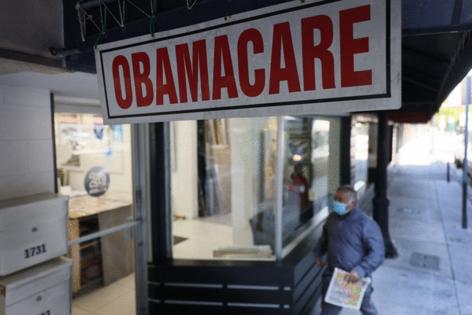'Huge sticker shock': Floridians get first look at Obamacare price hikes
Published in News & Features
Nathan Sharp is trying to figure out how he’ll pay for health care now that the federal pandemic-era help that made his coverage more affordable is set to end.
The 49-year-old Crystal River resident learned this week the monthly cost of his Affordable Care Act, or Obamacare, plan will more than double, jumping from $202 to $450. He said his co-pays are also increasing, and he’s considering going without coverage next year.
“I am not going to be able to afford my insurance,” said Sharp, who does digital marketing and is self-employed. “I am just going to have to self-pay.”
Millions of Floridians are facing higher Obamacare prices with the start of open enrollment Saturday. Costs are being driven up by the expiration of enhanced subsidies, enacted in 2021, that helped many people pay for health insurance — and are now at the center of the federal government shutdown dispute.
The Sunshine State has about 4.7 million people enrolled in Affordable Care Act plans, and it’s estimated as many as a third could drop their coverage given the higher prices.
“There is going to be huge sticker shock,” said Steve Freedman, a professor of health policy at the University of South Florida’s Chiles Center. “It’s not going to be without real public outcry.”
Rates will vary based on a person’s age, income, coverage plan and location. Obamacare is meant to make health insurance more affordable and accessible to people who do not access insurance through an employer, and about 97% of Florida enrollees receive income-based discounts that make their premiums cheaper.
But next year, many are slated to pay more for the same coverage, assuming Congress allows the extra subsidies to expire at the end of the year.
A 28-year-old person in Orange County who earns $35,000 a year will see the monthly cost of the typical silver-tier plan rise from $130 to $290, according to estimates from the Florida Office of Insurance Regulation. The typical family of four with a household income of $85,000 would see their monthly cost go from $489 to $901.
Despite the state’s rightward shift, Florida leads the nation for Obamacare enrollment, with more people relying on this coverage than anywhere else in the country. One factor behind that is Florida’s tourism and service-based economy, where many workers don’t have access to insurance through their jobs, Freedman said.
As a result, Floridians — from restaurant employees to gig workers to the self-employed — have turned to a plan long derided by the GOP to get health insurance.
In 2021, former President Joe Biden signed legislation making Obamacare subsidies even more generous and, for the first time, offering discounts to people earning more than four times the poverty level — about $62,600 for an individual.
With those changes, Obamacare enrollment soared in Florida from 1.9 million in 2020 to 4.7 million in 2025.
Those additional subsidies are now at the center of a Washington, D.C., standoff with Democrats pushing for them to be extended as part of a deal to reopen the government. It would cost about $23 billion to extend the subsidies for a year, and $350 billion to extend them over the next decade, according to an estimate by the Congressional Budget Office.
Long critical of Obamacare, many Republicans are pushing for a conservative overhaul of the 2010 law if not an outright repeal. But they haven’t coalesced around a detailed plan. Some conservatives argue extending the subsidies will drive health care costs even higher in the long run. Others, such as Rep. Marjorie Taylor Greene of Georgia and Sen. Josh Hawley of Missouri, have said they support extending the subsidies or coming up with a different plan to prevent dramatic price spikes.
Health care is shaping up to be a dominant issue in next year’s midterm elections.
But State Rep. Robin Bartleman, D-Weston, said she is worried about what the immediate fallout will be for families.
“They are about to get the shock of their lives when they open their premium notice,” she said. “Working families in Florida are at the end of their rope. They don’t have any room in their budget. This is going to be a real problem.”
Both outgoing Florida Gov. Ron DeSantis and gubernatorial front-runner U.S. Rep. Byron Donalds have said they think younger people could get by with bare-bones plans that provide coverage only for catastrophic costs instead of more expensive comprehensive coverage.
DeSantis put blame on federal policy that he says has created a “medical industrial complex,” where patients are disconnected from the cost of health care billed to insurers.
“Most people, particularly under 50, what they really need is a catastrophic plan that’s affordable, where then they can pay whatever they’re doing out of a health savings account,” he said during a discussion at Stanford University’s Hoover Institution earlier this month.
Meanwhile, Florida Blue, a leading insurance carrier, is warning its customers of the higher costs for those who buy insurance through the Obamacare marketplace and also highlighting the out-of-pocket expense of receiving treatment without insurance. The average emergency room visit at a Florida hospital costs $3,100 if you pay out of pocket, while a three-day hospital stay runs about $30,000, according to the insurer.
“Without the enhanced tax credits, millions of people will face higher monthly costs on the individual marketplace,” said Michael Lawrence, a Florida Blue spokesman. “They may no longer be able to afford their current coverage, and many may choose to go without it. This would reverse the tremendous progress — reduction in the uninsured — made since the Individual Marketplace began.”
Florida is one of 10 states that have not expanded Medicaid, a joint state-federal insurance program for low-income people. The Affordable Care Act included funds for states opting to expand Medicaid to people with incomes up to 138% of the poverty level, about $21,500 for a single person. The federal government agreed to initially fund 100% of the cost and pick up a 90% share in subsequent years.
The Florida Policy Institute, a left-leaning think tank, forecasts that the state’s uninsured could rise from 10.9% to 16.9% next year, writing that cuts to Medicaid and Affordable Care Act subsidies “set Florida up for an impending health care coverage disaster.”
As healthier people drop their coverage, it could cause an insurance “death spiral” with a sicker, riskier insurance pool, driving premiums even higher, said Freedman, the health policy professor. Emergency rooms could see more uninsured patients who must be seen but can’t pay, costs that ultimately get passed on to those with insurance.
Xonjenese Jacobs, the director of the health care assistance program Covering Florida, encouraged people facing large increases to shop around. They may be able to find a lower-tier plan or a different carrier that is less expensive and meets their needs, she said.
Navigators are available to provide free assistance to consumers, but their numbers have been greatly diminished because of federal funding cuts. Jacobs oversees 75 navigators, down from about 200 during Biden’s administration, even as many Floridians are expected to be scrambling for coverage.
“We’ve been fielding calls,” she said. “It has been off the hook with the phones ringing.”
_____
©2025 Orlando Sentinel. Visit orlandosentinel.com. Distributed by Tribune Content Agency, LLC.







Comments